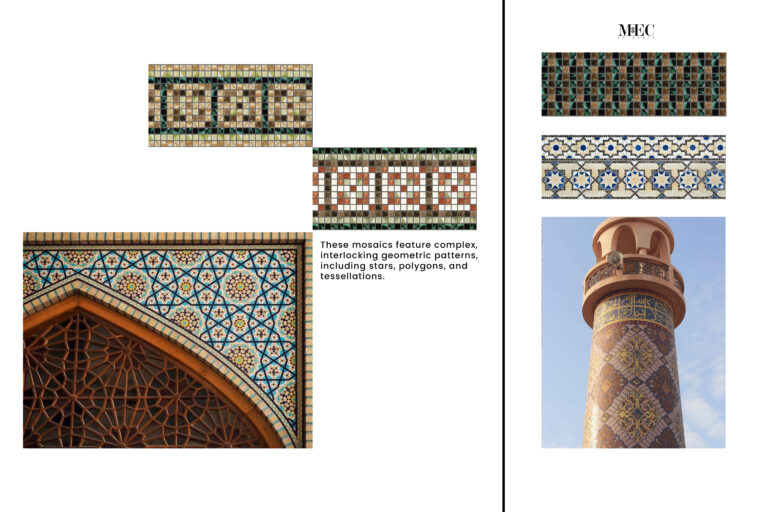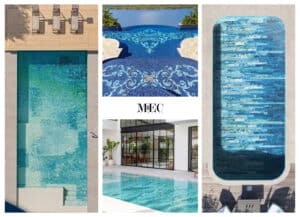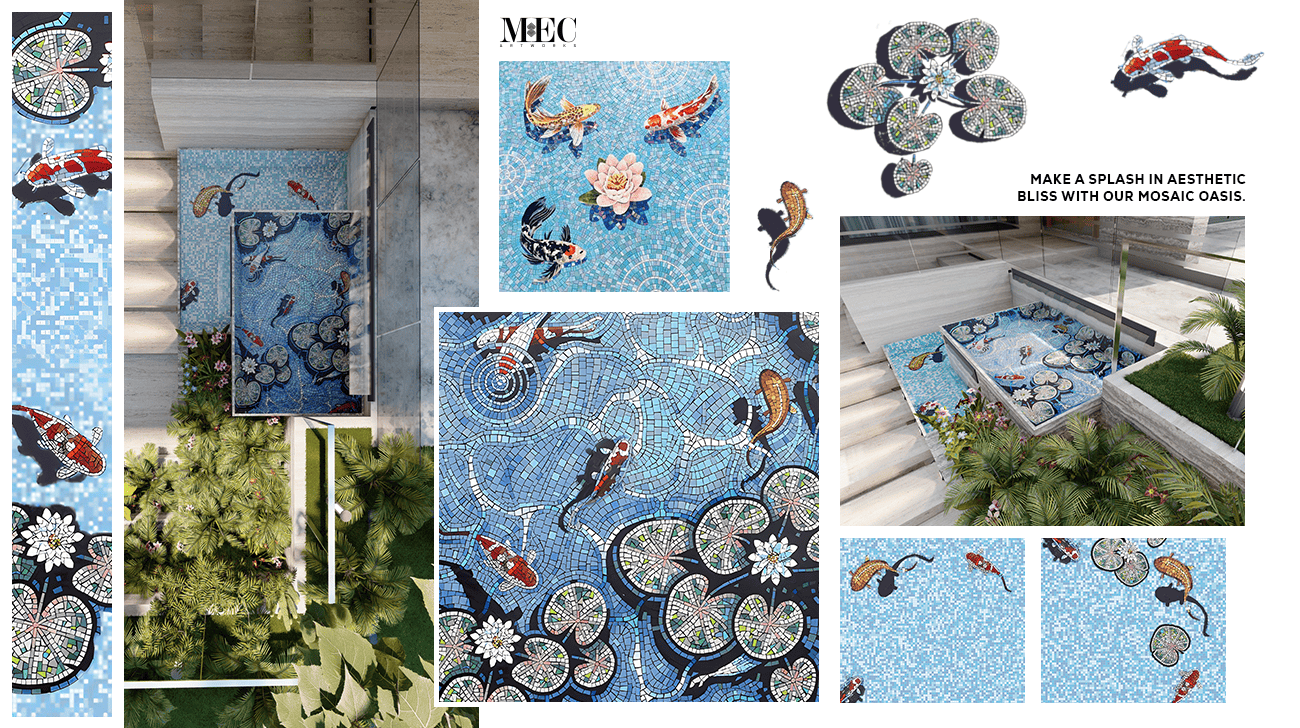Mosaic art is a common sight in mosques, as any visitor would see if he visits a mosque for the first time.
This is because mosques and other sacred places for Muslims rely heavily on mosaic art for ornamentation.
Islamic mosaic art encompasses various forms, patterns, and motifs. This blog will explore the types of mosaic styles used in Islamic art. In this article, we will discuss Types of mosaic styles in Islamic art.
Table of Contents
What is Islamic mosaic art?
The “bull’s-eye” pattern, typical of Islam but uncommon in Roman mosaics, features a large black center around one or more rings. A design element of two colors blended creatively is commonly used on the outermost ring.

- Mosaic art has graced Islamic architecture and buildings for millennia. Using tiny colored bits of clay, glass, or stone, this creative process painstakingly assembles geometric mosaic designs, floral mosaic patterns, or words. Several significant Islamic structures’ floors, walls, and ceilings are decorated with mosaics.
History and Background of Islamic mosaic art
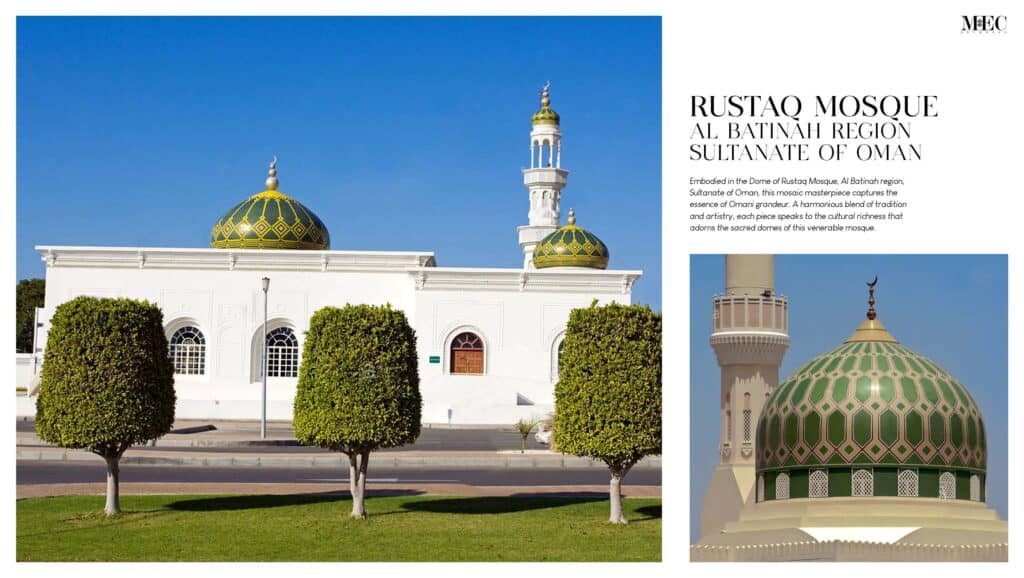
In the early years of the Abbasid kingdom, people bought Islamic mosaics to put in their homes and religious places. Glass mosaic tiles and other new ways to make mosaic tiles quickly took the place of marble mosaics in the 9th century. They were put on floors and walls to cover them.
Notable Examples of Islamic Mosaics
Notable examples of Islamic mosaics date back to c. 688-692. Some of the most prominent mosaic artwork are mentioned below.
Dome of the Rock, Jerusalem (c. 688-692):
Dome of the Rock is a significant example of Islamic mosaic art, and it dates back to years ago.
- The outside and interior are adorned with murals that harken back to the Byzantine period.
- Mosaics typically featured intricate floral and geometric designs rather than human figures.
Umayyad Mosque, Damascus:
- There is mosaic artwork in the courtyard, including the “Barada Panel” and other areas.
- Mosaic art depicts a prehistoric planet adorned with flowers, trees, and little towns in its own style.
Non-Religious Mosaic Works
- Hisham’s Palace:
Roman villa patterns served as an inspiration for the Umayyad mosaics, including the “Tree of Life” panel.
Transition to Tilework
- Great Mosque of Cordoba (c. 965-970):
- Then Islamic mosaics created in Spain began to use painted tilework rather than Byzantine embellishments.
- Over time, painted tilework replaced mosaic art as the preferred method of interior decoration in Islamic homes.
Types of Islamic Mosaic Art
There is a wide variety of artistic techniques, regional influences, and cultural traditions represented in Islamic mosaic art. To be considered a genuine Islamic mosaic, certain components must be present:
1. Geometric Mosaics
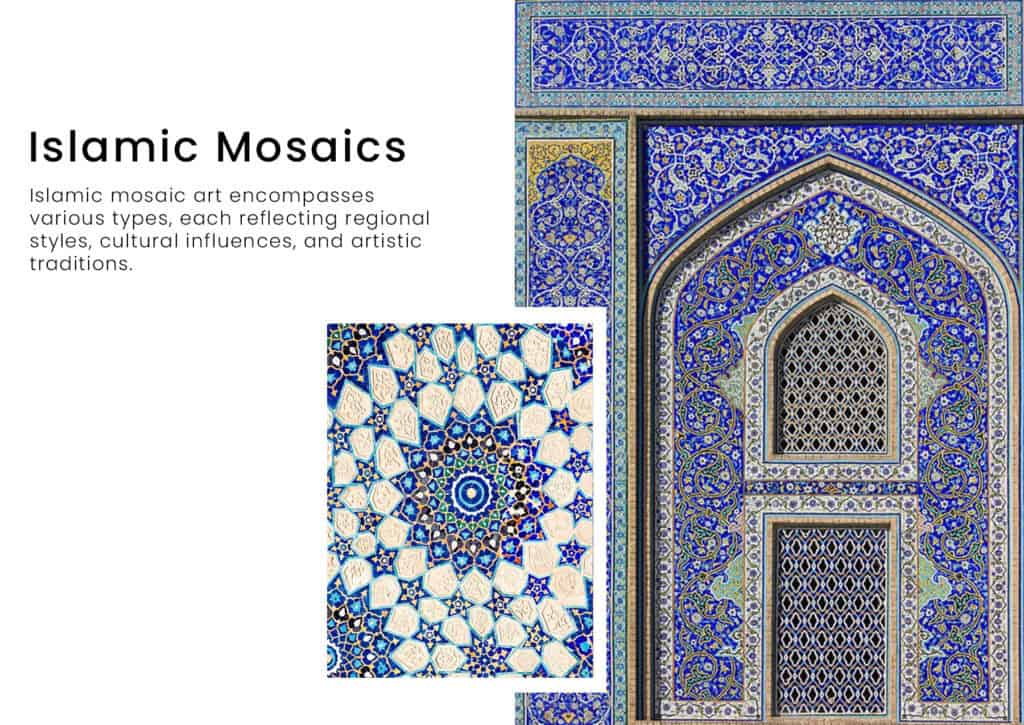
- Features: Various geometric designs, including tessellations, polygons, and star patterns, adorn these mosaics. The patterns’ mathematical accuracy and inherent symmetry represent Almighty Allah.
- Example: Two stunning examples of this kind of architecture are the Alhambra in Spain and the Great Mosque of Kairouan in Tunisia.
2. Floral and Arabesque Mosaics

- Features: In arabesques, ordinary garden elements like vines, flowers, and leaves are stylized and used as decorative patterns. The designs were born out of many hours of alone contemplation and meandering. The naturalistic influence of these designs makes them seem like they belong in a paradisiacal paradise.
- Example: Two such examples are Jerusalem’s Dome of the Rock and Damascus’ Great Mosque.
3. Calligraphic Mosaics
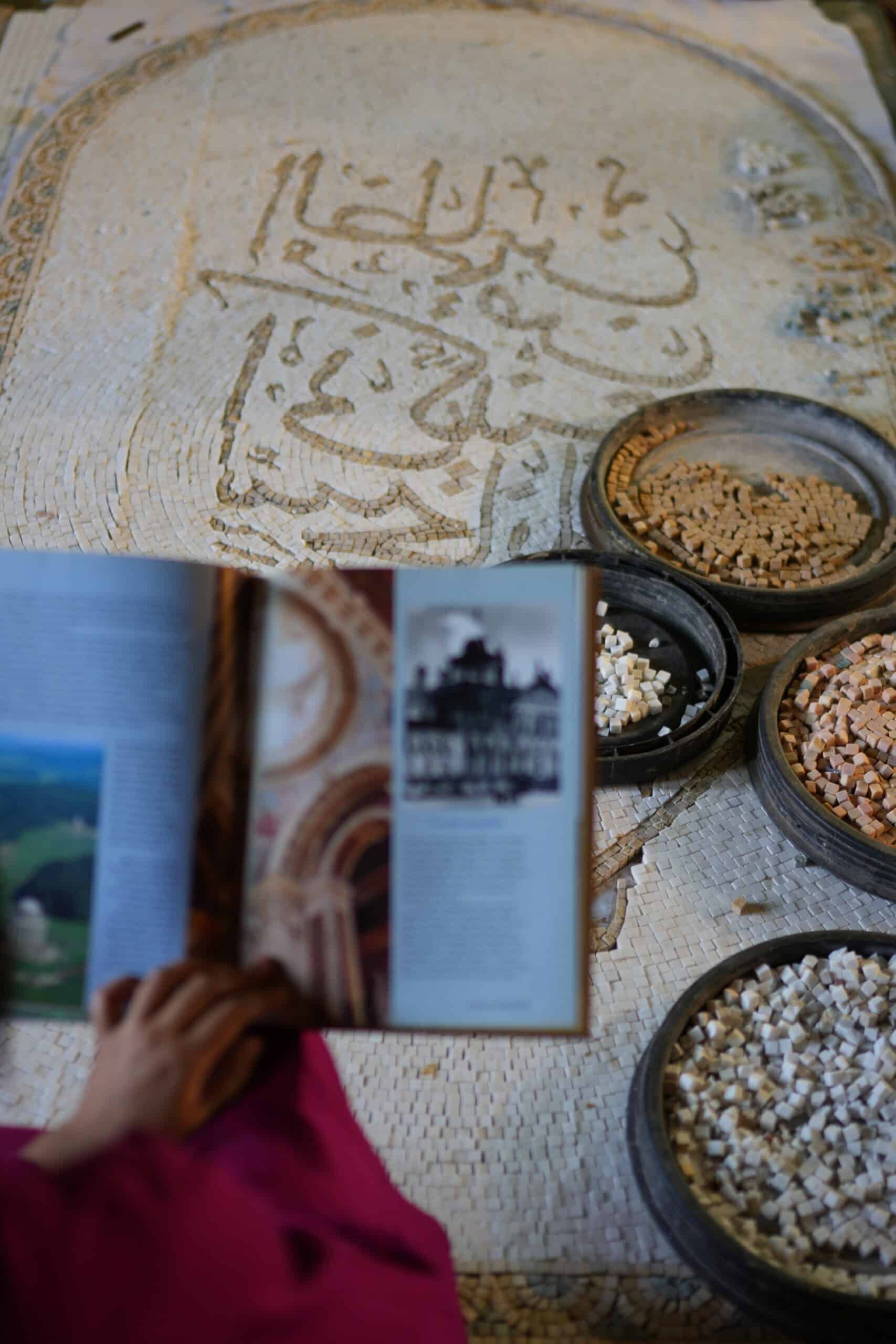
- Features: The Quran’s verses in Arabic calligraphy and other religious inscriptions are notable characteristics. The incorporation of calligraphy mosaic art design serves to subtly juxtapose the more obvious features, such as floral or geometric designs.
- Example: The Alhambra and the Great Mosque of Cordoba, two of the world’s most renowned Islamic structures, are prime examples.
4. Figurative Mosaics
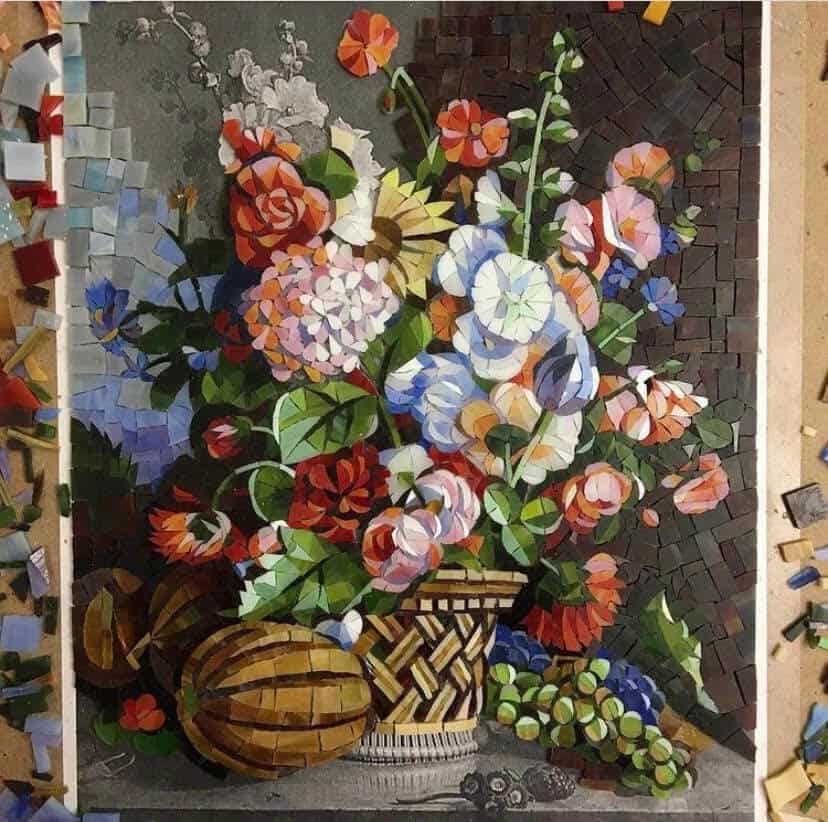
- Characteristics: Mosaics from Islamic countries occasionally feature religious scenes with animal and fruit mosaic art. These tend to stay away from human figures to respect Islamic antiquity; they are more prevalent in secular places like palaces.
- Examples: The Palestinian palace of Hisham with its “Tree of Life” mosaic.
5. Zellige

- Characteristics: The intricate patterns created by hand-cut tiles of various colors, typically in geometric shapes, are what give a mosaic its distinctive look. Many people in North Africa believe that this creative genre originated in Morocco.
- Examples: Moroccan mosaic art castles, madrasas, and mosques stand out.
6. Azulejo

- Characteristics: A form of painted, glazed tilework that became popular in Islamic Spain (Al-Andalus) and later spread to Portugal. Azulejos often feature geometric patterns, floral designs, and sometimes figurative scenes.
- Examples: Found in the Alhambra in Spain and later adapted into Portuguese architecture.
Islamic mosaic art showcases the diversity and complexity of Islamic decorative traditions via its diverse forms, which mix religious meaning with artistic expression.
Features of Islamic Mosaic art
The characteristic features of Islamic mosaics, a reflection of Islamic aesthetics and principles, include a lack of realistic artwork, rich colors, and complex geometric patterns. Some typical mosaic elements are as follows:
1. Islamic Mosaics Inside the Dome
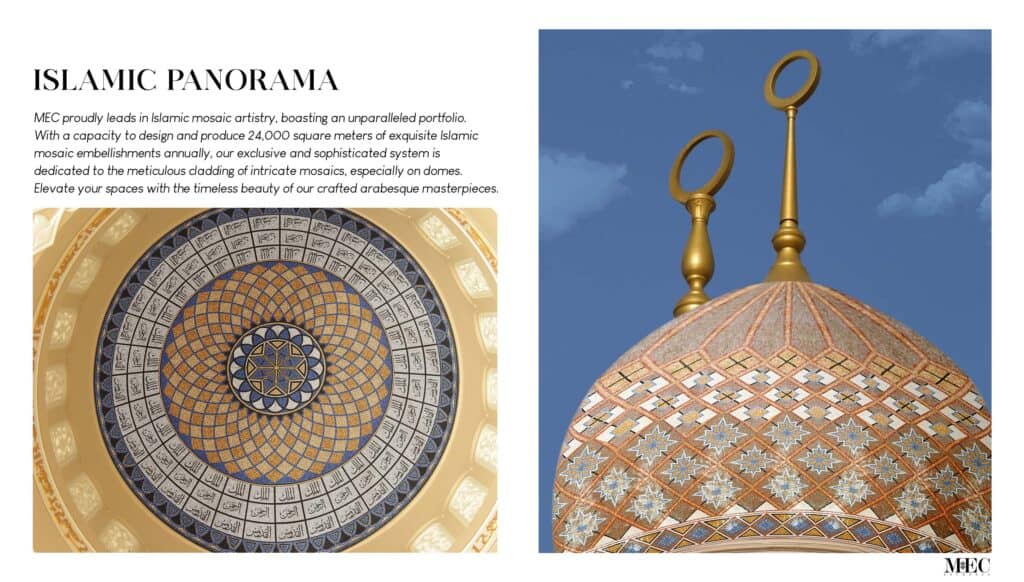
Mosques and other Islamic sacred buildings enhance the spirituality within with their beautiful mosaics covering their domes. The following are typical mosaic components:
- Golden Backgrounds: Gold dome mosaics have a transcendent light that represents everlasting purity and light.
- Complex Geometries: Because of the unusual shape of the dome, artists can display intricate floral and geometric patterns.
- Celestial Themes: Through the use of star patterns and other celestial components, certain dome mosaics represent the sky, further emphasizing the relationship between the hallowed place and the heavenly.
2. Golden Mosaics in the Dome

Golden mosaics, particularly within domes, are a hallmark of Islamic architecture. As a rule, they contain:
- Radiant Glow: The golden mosaics reflect the light in such a manner that they create an inner brilliant and paradisal atmosphere, adding to the room’s sanctity and magnificence.
- The symbolism of Gold: Islamic art that uses gold emphasizes the mosque’s function as a place of prayer since gold stands for the divinity and eternity of God.
- Contrast with Other Colors: Golden tiles contrast sharply with dark greens and blues, a popular combination that will catch the eye.
3. Islamic Mosaic Art on Walls

Many structures, including palaces and mosques, include Islamic mosaic art on their walls. Important aspects consist of:
- Tessellation: The tessellation method is used to cover walls with patterns by arranging things such that they fit tightly together without spaces or overlaps. It seems like these patterns can be duplicated forever.
- Glazed Tiles: The majority of wall coverings are small glazed tiles in a wide variety of colors and patterns, ranging from basic geometric forms to intricate floral motifs.
- Narrative Elements: Wall mosaics can convey tales or messages via the use of calligraphy that emphasizes Quranic passages or famous proverbs.
4. Tile Mosaic Mihrab

Beautiful tile mosaics can adorn the mihrab, a niche in the wall that faces Mecca, in mosques. The main components are listed below:
- Intricate Geometries: The geometric and floral tile work that adorns the mihrab enhances its religious and artistic significance.
- Use of Color: The utilization of profound blues, turquoise, and gold emphasizes the mihrab’s status as a praying site.
- Calligraphy: Ringing the mihrab from time to time are verses from the Quran engraved in flowing Arabic calligraphy, fusing artistic expression with religious instruction.
5. Islamic Mosaic Calligraphy
Calligraphy, a visual representation of writing talent, is often featured in Islamic mosaics.
- Religious Texts: Mosaics are both a visual art form and a religious practice; they often incorporate religious phrases or passages from the Quran.
- Stylized Fonts: There is a striking contrast between the geometric background and the flowing and curving Arabic calligraphy styles, such as Kufic and Thuluth.
- Integration with Design: The use of calligraphy in mosaics allows for the natural merging of text with ornamental elements. The visual and spiritual dimensions of the art form are brought together in this way.
These features collectively showcase the richness of Islamic mosaic art, blending faith, tradition, and aesthetics into mesmerizing designs.
Qatar Mosque Project by MEC Artworks
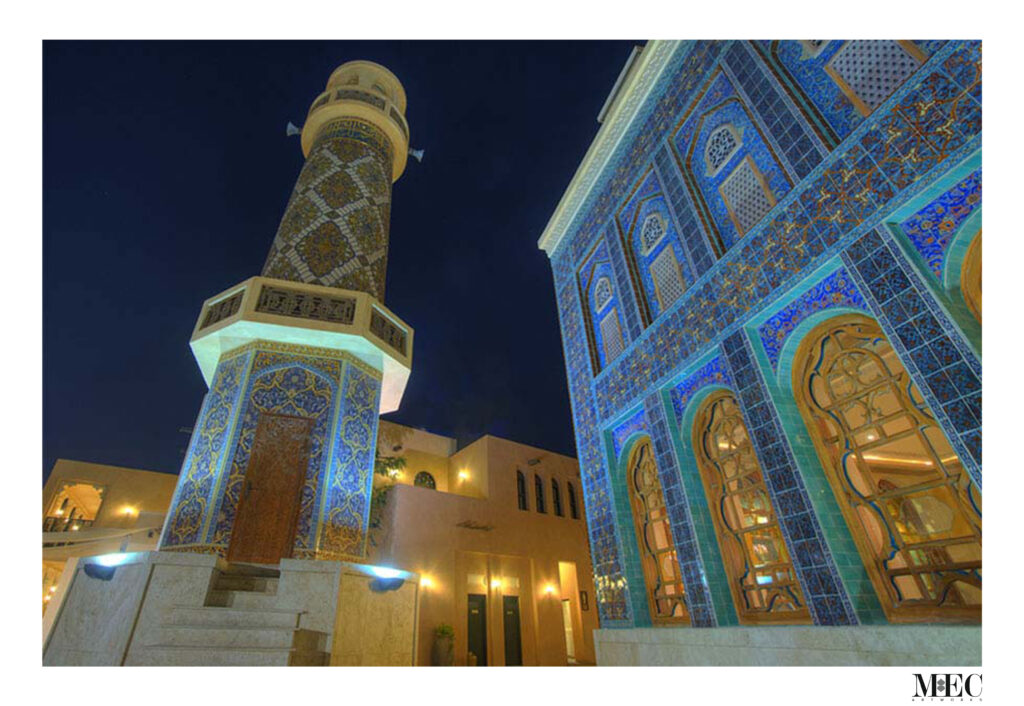
I. Introduction
MEC Artworks recently completed the fabrication of a stunning mosaic artwork for a mosque in Qatar. Blending traditional craftsmanship with modern design, this intricate piece enhances the spiritual ambiance of the mosque, reflecting the beauty and elegance of Islamic art.
II. Calligraphy in the mosque

Exquisite islamic calligraphy using mosaic tiles for the mosque in Qatar has been mesmerizingly designed, blending artistry with spiritual expression. The calligraphy, composed of intricate Arabic script, beautifully reflects the elegance and depth of Islamic tradition.
III. Dome Mosaics
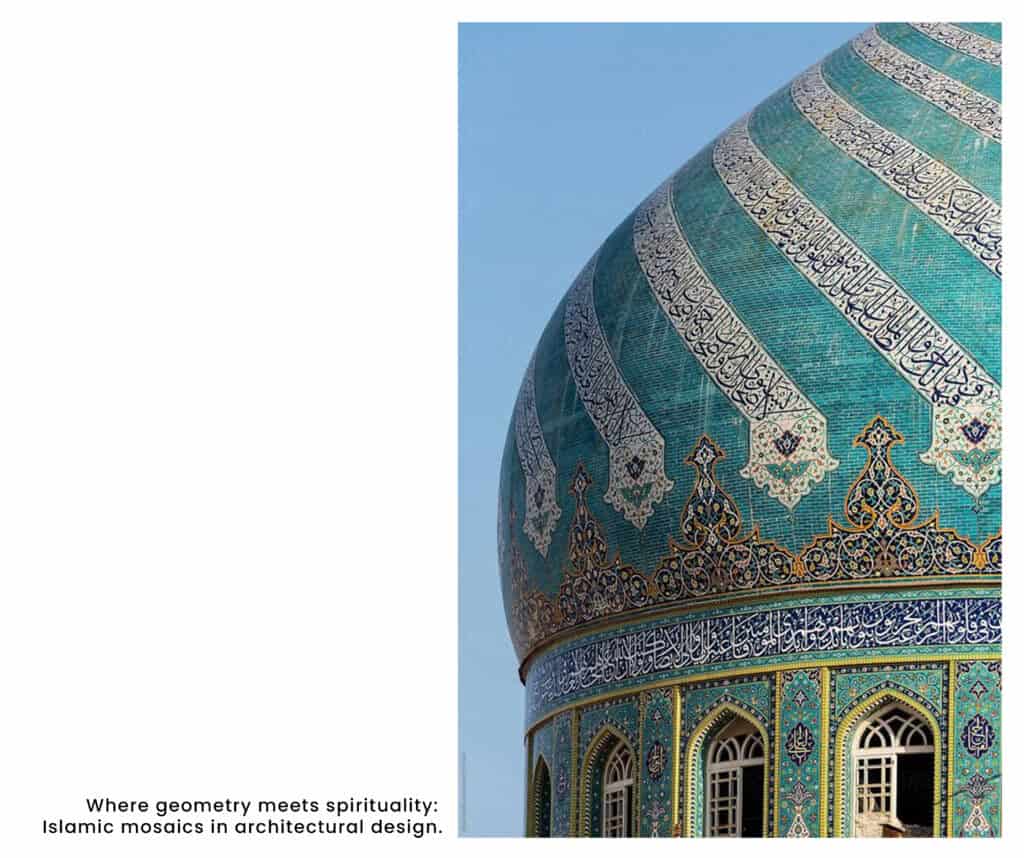
A breathtaking dome mosaic for a mosque in Qatar was made, using high-quality mosaic tiles. This dome is a masterpiece, featuring intricate geometric patterns and vibrant colors, perfectly aligned with Islamic artistic traditions.
The use of mosaic tiles creates a shimmering effect as light interacts with the design, adding depth and elegance to the structure. MEC’s attention to detail and dedication to preserving cultural artistry has made this dome a standout feature of the mosque, symbolizing both spiritual elevation and artistic excellence.
IV. Wall Art

The design features a harmonious blend of geometric patterns, floral motifs, and calligraphy, all meticulously handcrafted to reflect the rich cultural heritage of the region.
Where can Islamic mosaic art be installed?
Muslims have been creating beautiful mosaics for centuries, and they may enhance the spirituality, beauty, and practicality of any structure. Here are a few instances when this intricate art style has been put into practice:
1. Domes and Ceilings:
- Purpose: Awe and a sense of one with God are evoked by dome and ceiling decorations with geometric motifs and arabesques.
- Application: The domes and ceilings of mosques, palaces, and other great rooms can be adorned with Islamic mosaics. The infinite and everlasting character of the divine is symbolized by the recurrent patterns.
2. Mihrabs:
- Purpose: One stares into a niche in the wall mihrab mosaic when praying at a mosque; it shows the direction of Mecca.
- Application: To highlight the sacredness of the area, elaborate mosaics often utilize geometric designs and Quranic calligraphy. You may find mosaics made of stone, glass, or ceramic here.
3. Walls:
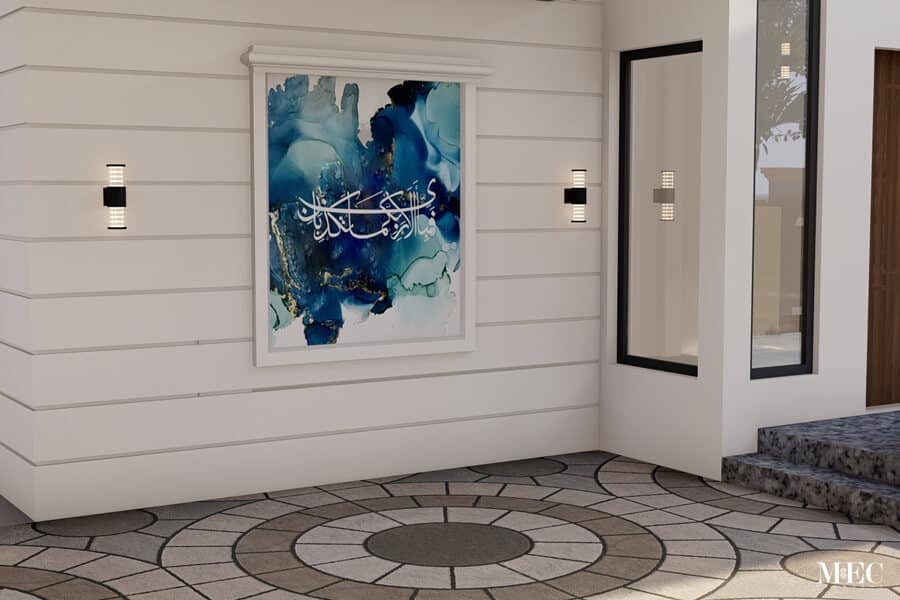
- Purpose: Islamic law permits the decoration of both the inside and outside of a building with mosaics.
- Application: Vibrant, repetitive patterns or calligraphy adorn the walls of many houses, mosques, and castles. Foyers, chapels, and courtyards often have mosaic flooring since it is beautiful and widely utilized.
4. Fountains and Water Features:
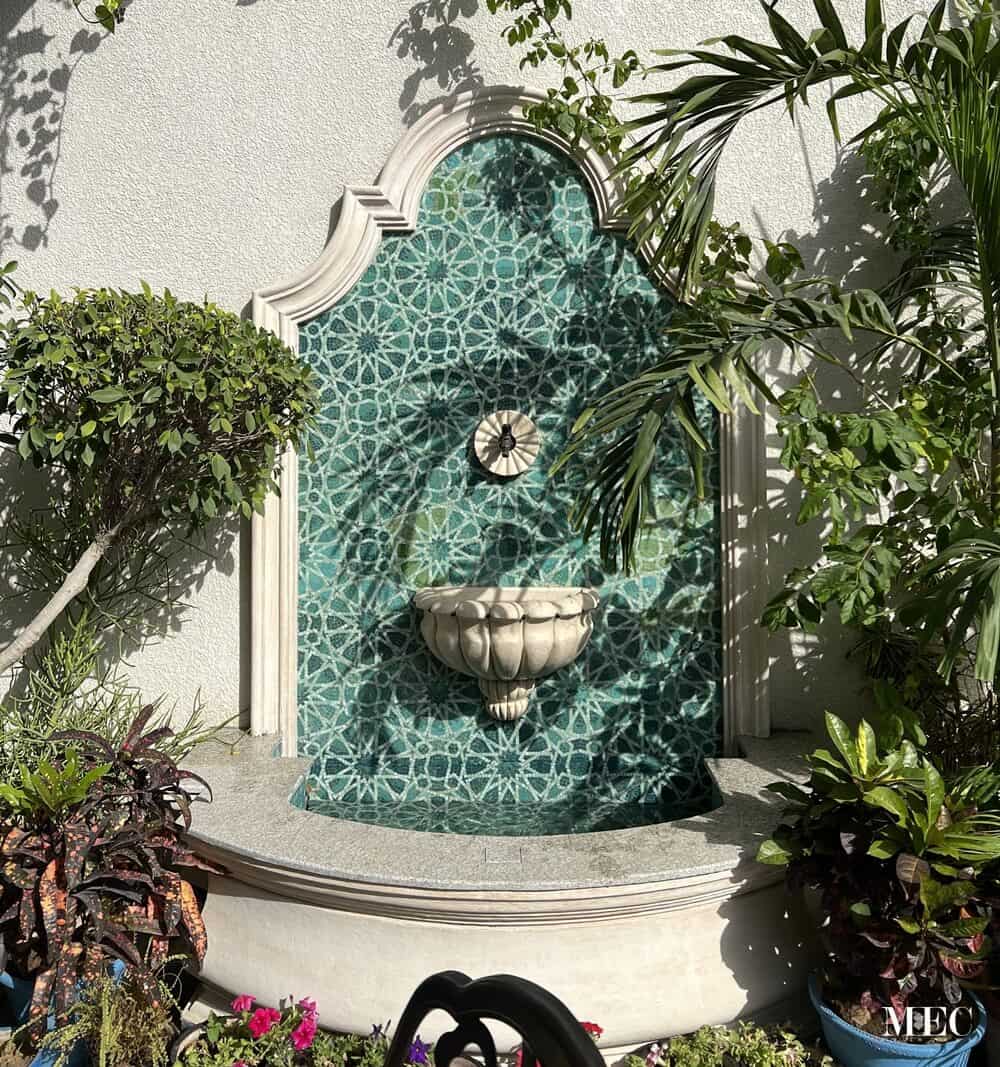
- Purpose: Nirvana and sanctity are symbolized by water elements for Muslims.
- Application: Mosaics may be a beautiful addition to water channel basins for fountains in gardens, courtyards, and castles. When reflected in water, the mosaics’ ornate patterns and vivid colors pop.
5. Monuments and Facades:
- Purpose: Public buildings and Islamic sites often adorn their exteriors with mosaic art.
- Application: Mosques and madrassas, two examples of public buildings decorated with mosaic tile ornamentation, are visual expressions of Islamic devotion. Geometric shapes and floral motifs are common examples of designs used for these ornaments.
6. Living Rooms and Hallways:
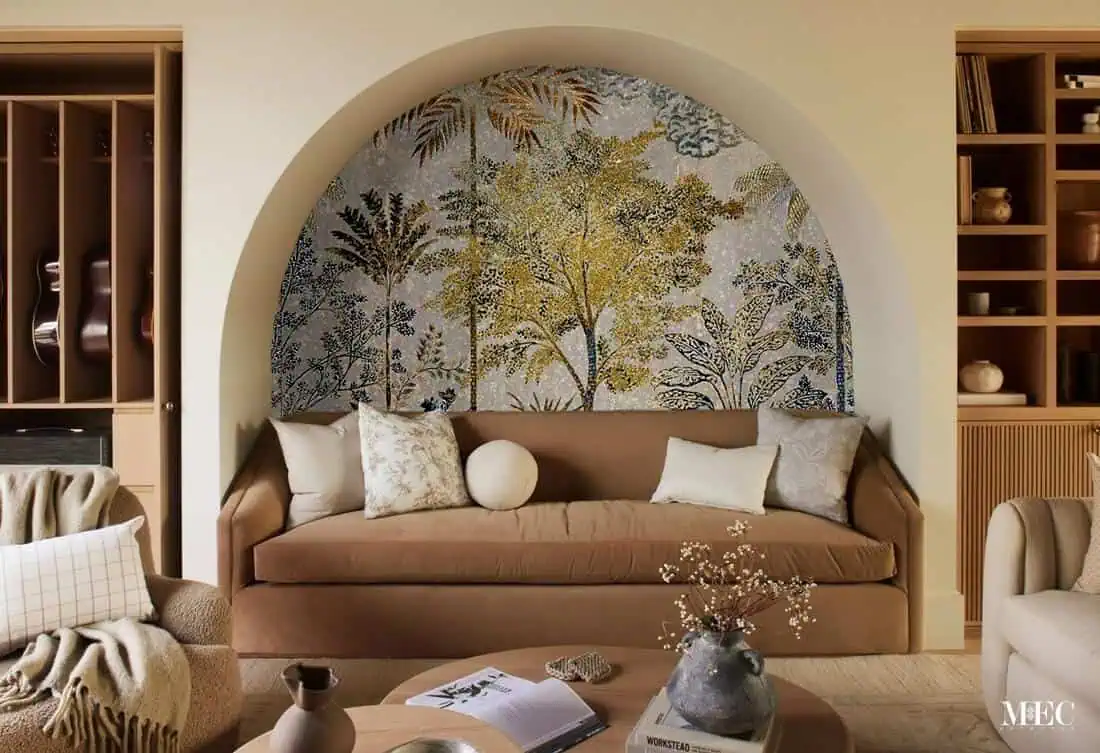
- Purpose: Beautiful and culturally significant, Islamic mosaic art is a great way to spruce up any space.
- Application: Mosaics are multipurpose and may be used as floor or wall décor, as well as decorative pieces in living rooms or corridors. Often including delicate arabesques or subdued geometric patterns, these artworks aim to evoke a calming mood.
7. Libraries and Museums:
- Purpose: In addition to its aesthetic value, mosaics are a great way to showcase and preserve Islamic art and culture.
- Application: Museums and libraries often display Islamic mosaics as floor tiles, wall installations, or even as solitary works of art inside their interiors. As a teaching tool, visitors may study the intricate details of Islamic art while also learning about its illustrious past.
Any one of these locations would be blessed culturally, spiritually, and aesthetically by Islamic mosaics.
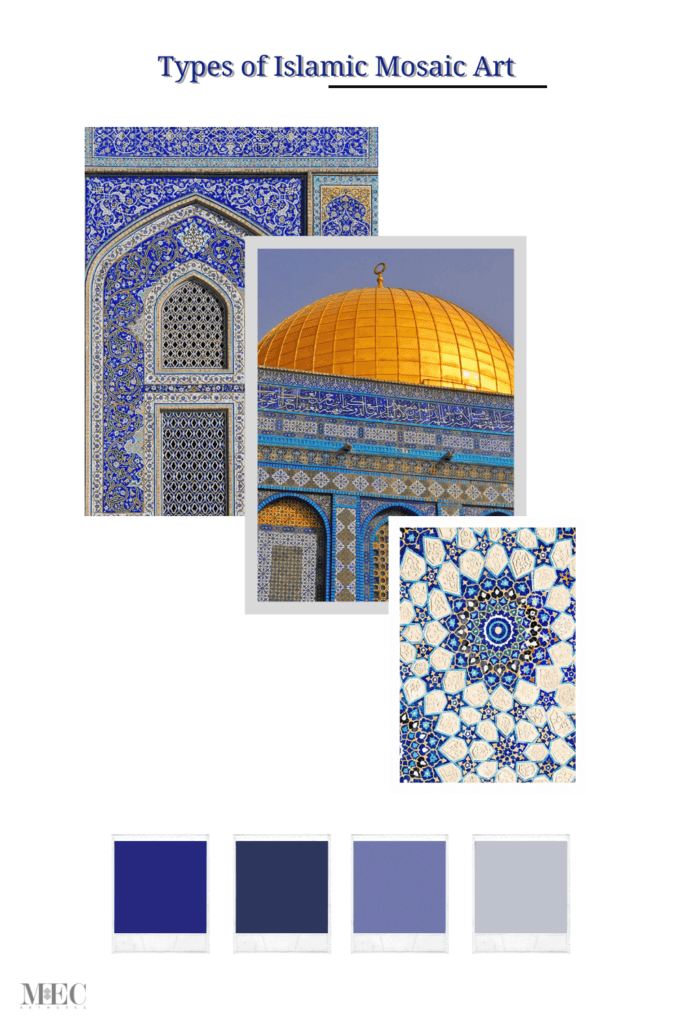
Conclusion
Thus, from this point of view, Islamic mosaic art is a very deep expression of spiritual and cultural values, connecting the beauty of nature with religious symbolism united with mathematical calculation. Starting from intricate geometric patterns decorating mosques, flowing arabesques, and calligraphic inscriptions outlining mosques, all of it shows the principle of unity and infinity connected by Islam. Islamic mosaics decorate the domes, walls, and floors of sacred and secular shrines, crossing time and geography, leaving a hallmark of architectural elegance and spiritual reverence. Timeless art constantly draws inspiration from elevating spaces to an intrinsic feeling of wonder, peace, and presence with the divine.
FAQ’s
What are the styles of Islamic art?
Islamic decoration primarily consists of four elements: geometric patterns, calligraphy, depictions of figures, and patterns of plants. The most appreciated and basic component of Islamic art is calligraphy. It is noteworthy that the Qur’an, the book of God’s revelations to the Prophet Muhammad, was sent in Arabic. The Arabic alphabet alone offers the possibility of creating a range of decorative shapes.
What is Islamic mosaic art?
The canes of an Islamic mosaic jar will feature a u0022bull’s-eyeu0022 design, distinguishing it from a Roman one. One or more rings around a big monochromatic center; the outermost ring is often made of two opposing hues that mix to create entertaining patterns.
What are the most famous Islamic mosaics?
Damascus, the capital of the Arab Caliphate, is home to the Umayyad Mosque, which has some of the most significant early Islamic mosaics. The present-day mosque has its origins in the time between 706 and 715. The caliph engaged two hundred talented Byzantine artisans to adorn the structure. The mosque has tourists of 500,000 to 1 million annually.
What is the basic type of Islamic mosaic art?
Circles and interlaced circles, squares or four-sided polygons, the ever-present star pattern (really simply a circle with squares and triangles inside it), and multisided polygons are the four fundamental forms from which complex patterns are formed.
Why do mosques have mosaics?
Given the significance of mosaics to Roman artistic culture, it is likely that the caliphate was portrayed in eighth-century mosque and palace mosaics as a natural extension of the Roman Empire.
